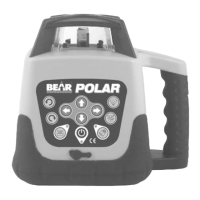sweeping beam line and move slightly up or down until you see that you are
centered on the beam, make your mark. If conditions make the beam difcult
to see, you can slow the rotation, scan the beam on the target surface or use a
receiver to nd the beam.
3. Turn the entire laser 180 degrees, ensuring that the height of the tripod does not
change as this will affect your results. The opposite Y-axis direction should now
be aimed at the target. Secure the laser, allow it to re-level and mark the laser
beam on the target.
4. The difference between the two marks (if any) is double the difference between
the laser’s calibration and true level for the Y-axis. Half way between these two
marks is true level. Make a long mark at true level. The calibration error of the
laser is the difference between either one of the original marks and true level.
(eg. If the difference between one mark and true level is 1mm and your laser is
30m from the target, then the calibration error of the laser is: 1mm @ 30m).
5. If the calibration error is within the stated specications of ±2.0mm @ 30m then
no calibration is required. If the calibration is outside of this specication do not
move the laser and proceed with the calibration procedure for the Y-axis outlined
in 7.2.1
— 16 —

